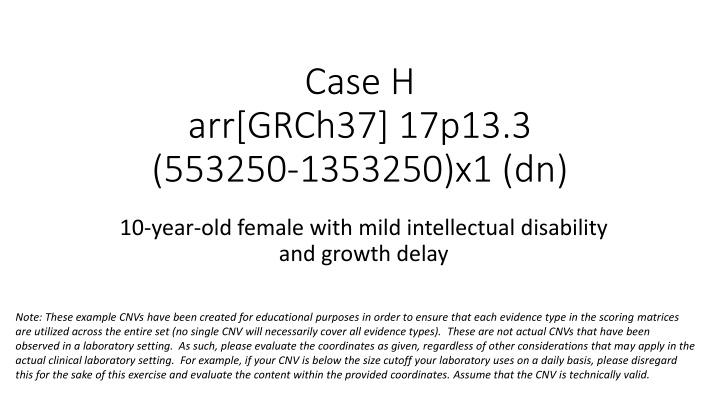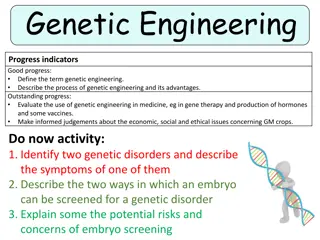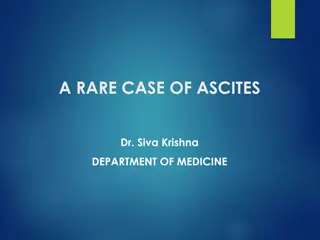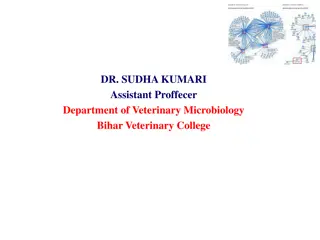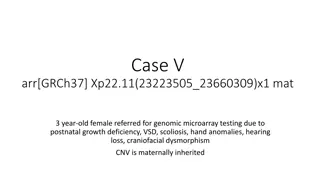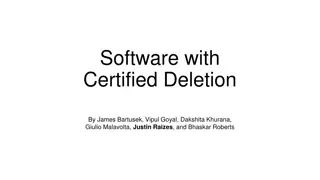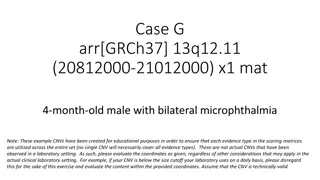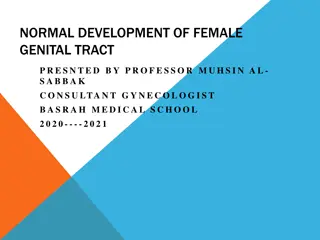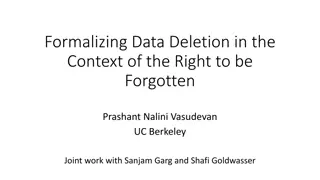Genetic Analysis of 17p13.3 Deletion in a 10-Year-Old Female
This genetic case study involves a 10-year-old female with a de novo 17p13.3 deletion, presenting with mild intellectual disability and growth delay. The deletion overlaps with the Miller-Dieker syndrome critical region, impacting genes associated with lissencephaly and cognitive impairment. Through detailed genomic evaluation, the loss scoring metric was applied, with a focus on protein-coding genes and predicted haploinsufficient genes. Overall, the genomic content assessment reveals potential implications for the individual's clinical presentation.
Download Presentation

Please find below an Image/Link to download the presentation.
The content on the website is provided AS IS for your information and personal use only. It may not be sold, licensed, or shared on other websites without obtaining consent from the author.If you encounter any issues during the download, it is possible that the publisher has removed the file from their server.
You are allowed to download the files provided on this website for personal or commercial use, subject to the condition that they are used lawfully. All files are the property of their respective owners.
The content on the website is provided AS IS for your information and personal use only. It may not be sold, licensed, or shared on other websites without obtaining consent from the author.
E N D
Presentation Transcript
Case H arr[GRCh37] 17p13.3 (553250-1353250)x1 (dn) 10-year-old female with mild intellectual disability and growth delay Note: These example CNVs have been created for educational purposes in order to ensure that each evidence type in the scoring matrices are utilized across the entire set (no single CNV will necessarily cover all evidence types). These are not actual CNVs that have been observed in a laboratory setting. As such, please evaluate the coordinates as given, regardless of other considerations that may apply in the actual clinical laboratory setting. For example, if your CNV is below the size cutoff your laboratory uses on a daily basis, please disregard this for the sake of this exercise and evaluate the content within the provided coordinates. Assume that the CNV is technically valid.
Clinical Information arr[GRCh37] 17p13.3(553250-1353250)x1 (dn) 10-year-old female with mild intellectual disability and growth delay Parental testing performed; variant is de novo Use the LOSS scoring metric
Section 1: Initial Assessment of Genomic Content Case H Genes Involved Would apply category 1A (contains protein-coding or other known functionally important elements), as this deletion includes numerous protein-coding genes. 0 points; continue evaluation Total: 0 points
Section 2: Overlap with Established/Predicted HI or Established Benign Genes/Genomic Regions Case H overlaps with the curated 17p13.3 region (both include YWHAE). Deletions of the 17p13.3 region are associated with Miller-Dieker syndrome (MDS), a condition characterized by lissencephaly, dysmorphic features, intellectual disability, and other congenital anomalies. Case H 17p13.3 region The MDS critical region includes BOTH PAFAH1B1 and YWHAE Loss of the PAFAH1B1 gene is known to be associated with isolated lissencephaly. Individuals with deletions including both PAFAH1B1 and YWHAE are more severely affected than those with loss of PAFAH1B1 only. Because PAFAH1B1 is not included, this is only a partial overlap of the critical region. Use Category 2B, 0 points Total: 0 points
Does CNV H include any predicted HI genes? These 2 genes meet criteria (Category 2H: 0.15 points). Total: 0.15 points
Section 3: Evaluation of Gene Number 12 protein-coding genes (Category 3A: 0 points) Total: 0.15 points
Section 4: Detailed Evaluation of Genomic Content Where to begin? Check if any of the genes in the region have been evaluated by ClinGen Dosage Sensitivity with scores other than 3 The 3 genes in the red box have been evaluated. YWHAE has a HI of 0 why?
Is there enough evidence to implicate YWHAE alone as a HI gene? YWHAE is known to be a part of the critical region for classic Miller- Dieker syndrome (along with PAFAH1B1) There have been numerous reports of individuals with deletions of 17p13.3 NOT including PAFAH1B1 that did not have classic Miller- Dieker syndrome, but did have other neurodevelopmental phenotypes YWHAE is often included in the smallest region of overlap for these cases, and is suspected to be contributing to this phenotype At the time of the ClinGen Dosage Sensitivity evaluation (June 2014), there had been no reports of deletions involving only YWHAE Is there now enough additional evidence to support YWHAE as a HI gene?
Noor et al. 2018 Report a deletion involving YWHAE only Minimally deleted region involves the entire exon 6; predicted to result in frameshift and premature truncation Variant is de novo; parental relationships assumed Proband described as having learning disabilities, short stature, myoclonic epilepsy, and brain abnormalities In addition to this, there are some reports in ClinVar of single gene deletions Conflicting interpretations Not enough evidence provided to independently assess As of May 2020, there is not enough evidence to say that loss of YWHAE ALONEresults in clinical phenotype. PMID:28542865
What about the region? Is there evidence to support the notion that loss of 17p13.3 including YWHAE but NOT PAFAH1B1 results in clinical phenotype? Assess cases similar in size/genomic content to CNV H
Nagamani et al. 2009 All variants de novo, parental relationships assumed All patients with developmental delay All patients with deletions involving YWHAE have postnatal growth restriction EXCEPT Patient 1 Patient 1 deletion involves only YWHAE and TUSC5, suggesting that the growth phenotype may be associated with another gene. * * * * * Cases being counted due to similarity in size/genomic content to CNV H. Category 4C, 0.10 points each. Approximate proximal boundary for CNV H; extends distally beyond the area shown in the figure. PMID:19584063 Total: 0.55 points
Bruno et al. 2010 Describe 8 individuals with deletions of 17p13.3 that include YWHAE but not PAFAH1B1 All had variable degrees of developmental delay; postnatal growth retardation varied from mild to pronounced Cases 1-5 and 8 are de novo (parental relationships assumed) Case 6 is inherited from a mother who had transient speech problems as a child and growth retardation Parents unavailable for Case 7 ** Approximate coordinates of Case H Dotted lines indicate deleted area of each case * Cases being counted due to similarity in size/genomic content to CNV H. Category 4C, 0.10 points each. PMID:20452996 Total: 0.75 points
Schiff et al. 2010 ** 4 additional patients reported Patients A, B, and C de novo; parental samples unavailable for Patient D Approximate coordinates of Case H All four individuals have intellectual disability and growth retardation * Cases being counted due to similarity in size/genomic content to CNV H. Category 4C, 0.10 points each. PMID:20599530 Total: 0.95 points
Case-Control Data Some similar 17p13.3 cases not involving PAFAH1B1 were observed Coe et al. 2014 case-control study. There do not appear to be similar observations in controls. Case H Coe et al. CASES Coe et al. CONTROLS PMID:25217958
Case-Control Data Note that the data from Coe et al. 2014 is in NCBI36/hg18; once lifted over, these coordinates are very similar to CNV H Deletions of 17p13.3 involving YWHAE but NOT PAFAH1B1 were observed in 17 cases referred for clinical microarray testing, and in 0 controls Specific phenotypes are unknown p-value is significant (<<<0.05) Likelihood ratio is infinity; confidence interval surrounding the likelihood ratio does not include 1 Statistically significant difference between cases (with nonspecific or unknown phenotype) and controls- Category 4M (0.30 points) Total: >1.0 points
Population Data Case H While there are numerous small deletions in DGV, none are comparable to Case H. The deletions in YWHAE are intronic. No comparable deletions in gnomAD SV.
Section 5: Evaluation of Inheritance Pattern/Family History for Patient Being Studied Our patient is a ten-year-old female with mild intellectual disability and growth delay Variant is de novo; not specified whether parental relationships were confirmed While non-specific, this phenotype is consistent with what has been reported in similar cases Category 5A: 0.10 points (de novo variant with non-specific phenotype, parental relationships assumed) Total: >1.0 points
Conclusion Classification: Pathogenic There are numerous additional cases not mentioned here of 17p13.3 deletions involving YWHAE but not PAFAH1B1. Even being conservative with the cases we have chosen to count as evidence, we have more than enough to classify this deletion as Pathogenic. Note that this patient would NOT be expected to have classic Miller Dieker syndrome, but rather the neurodevelopmental/growth restriction phenotype described in the deletion cases involving similar genomic content.
